Modified Falling Mass Impact Test Performance on Functionally Graded Two Stage Aggregate Fibrous Concrete
Abstract
:1. Introduction
1.1. Evolution of Fibrous Concrete
1.2. Functionally Graded Concrete (FGC)
1.3. ACI 544 Drop-Mass Impact Test
- A single-point impact on the specimen increased the chance of inaccurate findings—the point of impact could be a soft cement matrix or a hard coarse aggregate;
- Cracks were permitted in any direction and anywhere on the specimens—this strengthened the test subjectivity when cracking was inspected visually;
- Due to the lack of a standard, the test findings were dispersed;
- The specimen base, as well as the apparatus lug, were characterized as failures, and even with excessive fracture width, this failure observation could produce a recurrent impact on the specimen;
- Preparation of specimens was not based on any standard, so the specimens may have had mold-faced surfaces.
- Despite the numerous benefits of the ACI drop-weight impact test, the dispersed results were the primary disadvantage that must be addressed.
1.4. Proposed Modification to the ACI 544 Test Method
- It permitted the formation of cracks in any direction, complicating the identification of the initial visual crack;
- Since concrete has a heterogeneous material feature, the centre point that was immediately exposed to the focused force could be a coarse solid aggregate grain or a soft mortar region. As a consequence, results that will not accurately reflect the material’s impact strength could be achieved.
2. Research Significance
3. Experimental Investigation
3.1. Base Materials
- The cement used in this research had a specific gravity of 3.14 as per the IS 1489-2015 standard [70]. The conventional consistency of the blain fineness was 375 m2/kg; the consistency was 30.8%; and the initial and final setting times were 32 and 550 min, respectively.
- Natural river sand was used as the fine aggregate, meeting the requirement of IS 383-2016 [71]; the gradation curve was consistent with Zone II; the specific gravity was 2.65; and the fineness modulus was 2.41. The fine aggregate particle size was less than 2.36 mm, resulting in an excellent flowable grout blend in accordance with ASTM C939/C939M-16a [72].
- The coarser aggregate utilized were natural gravel with a size of 12.5 mm meets the requirement according to IS 383-2016 [71]. The apparent bulk density of the coarse aggregate was 1700 kg/m3, the specific gravity was 2.6, and the water absorption percentage was 0.56.
- The commercial superplasticizer Tech Mix 640 was utilised to reduce water and extend grout time in the plastic stage. A grout fluidifier typically is composed of a water-reducing additive at a suggested dose of 1% by cement content [73]. The water-reducing admixture dose was restricted to 0.4% in this research to provide excellent efflux time and flowability, and to avoid honeycombing.
- Fibre is widely used as a component in concrete reinforcement due to the many advantages it provides in this application. A new geometrically shaped macro polypropylene fibre (PF) and steel fibre (SF) were utilized in this study; the unique PF was 45 mm in length and 0.8 mm in diameter, with a tensile strength of 500 MPa; and the hybrid hooked-end crimped SF had a length of 50 mm, a diameter of 1.0 mm, and a tensile strength of 1200 MPa. The appearances of the PF and SF used in this research are illustrated in Figure 4.
3.2. Mixing Composition
3.3. Method for Preparation of a Specimen
3.4. Test Setup for Drop-Mass Impact
4. Discussion of Results
4.1. Compressive Strength of FTSFC
4.2. Impact Test Results
4.2.1. Effects of Single-Layered Concrete
4.2.2. Effects of Double-Layered FTSFC
4.2.3. Effects of Three-Layer FTSFC
- The recorded Q1 and Q2 values for the T-FG1 specimen were 101 and 357, respectively. When compared to the PAC specimen, the observed values improved by 5.61 and 11.16 times, respectively.
- For the T-FG2 specimen, the recorded values for Q1 and Q2 were 106 and 501, respectively. The observed values were increased by 5.88 and 15.65 times, respectively, compared to the PAC specimen.
- The recorded Q1 and Q2 values for the T-FG3 specimen were 94 and 279, respectively, and these values were increased by 5.22 and 8.71 times, respectively.
- The Q1 and Q2 values for the T-FG4 specimen were 112 and 608, respectively. These values tended to increase by about 6.22 and 19 times, respectively.
- The recorded Q1 and Q2 values for the T-FG5 specimen under the optimal circumstances were 116 and 742, respectively. The recorded values increased by 6.44 and 23.18 times, respectively.
- The Q1 and Q2 values for the T-FG6 specimen were 95 and 307, respectively. The recorded values were increased by 5.27 and 9.59 times, respectively.
- For the T-FG7 specimen, values of 105 and 389 were recorded for Q1 and Q2, respectively. The recorded values were increased by 5.83 and 12.15 times, respectively.
4.2.4. Impact Ductility Index (IDI) of FTSFC
4.2.5. Failure Pattern
4.2.6. Orientation of Fibres in FTSFC
4.2.7. Failure Mechanism of FTSFC Specimens
4.2.8. Comparison of ACI and Modified-Method Impact Results
4.2.9. Comparison of the Coefficient of Variance (COV) Calculated from the ACI and Modified-Method Impact Test Results
5. Conclusions
- The S-SF specimen demonstrated the greatest compressive strength, with a 59.6% improvement over the reference specimen (PAC). The T-FG2 specimen, which had 2.8% SF in the top and bottom layers and 1.6% in the intermediate layer, had the second-greatest compressive strength increase at 54.4%. As a result, single-layered concrete outperformed three-layered FTSFC in compression tests. On the other hand, steel fibres contributed more to improving strength than PF, independent of the fibre scheme or the number of layers.
- The reported Q1 increased by approximately 5.8 and 3.8 times for the S-SF and S-PF specimens, respectively. In comparison to PAC, the reported Q2 increased by about 17.5 and 5.2 times. For both Q1 and Q2, however, the effect of SF was greater than that of PF. This was caused by the introduction of fibres, which improved the matrix’s tensile capacity by providing high tensile-stress absorbance across fractures through crack spanning.
- The T-FG group of specimens had higher Q1 and Q2 records than the PAC sample, which was expected due to the fibre-matrix reinforcing effect. The T-FG5 combination from this group had the most significant increases in Q1 and Q2, by about 6.4 and 23.2 times, respectively. This was due to the greater SF dose in the top and bottom layers, which were subjected to higher impact stresses due to the immediate contact with the supplied drop weight and the supportive base plate. Furthermore, the crimped and hooked-end structure of SF and its considerably greater tensile strength than PF contributed to its enhanced bond strength. The second-highest Q1 and Q2 values for three-layered FTSFC, recorded for the T-FG4 specimen, were 112 and 608, respectively. These values tended to increase by about 6.22 and 19 times, respectively. The third-highest recorded values were for the T-FG2 specimen, which had a Q1 and Q2 of 106 and 501, respectively. The observed values were increased by 5.88 and 15.65 times, respectively, compared to the PAC specimen.
- The PAC had a ductility index value of 1.8, which indicated brittle failure. The ductility index value of all fibre specimens varied from 2.4 to 6.4, indicating a higher postcrack resistance. Moreover, a higher ductility was achieved by increasing fibre content in the top and bottom layers while reducing it in the intermediate layer.
- Better controlled cracking behaviour was achieved by using notched specimens and load-transmitting plates. The cracks in notched specimens mainly started and spread along the edges of the notches, while the specimens examined per the ACI 544-2R method had numerous randomly dispersed cracks. This type of controlled activity would make it simpler to identify criteria for accepting or rejecting the findings of the specimens tested based upon their cracking pattern, reducing the dispersion of the results even further.
- In comparison to the ACI technique, the modified-impact findings were considerably more significant. For Q1, the percentage difference between the ACI and modified impact test findings varied from −6 to 100%, while for Q2, the percentage difference ranged from 11.8 to 100.4%. Compared to the ACI test technique, the estimated COV values for all 12 mixes were reduced by 27.4 to 64.21% for Q1 and 6.3 to 70.16% for Q2. Consequently, the suggested impact-test modification can enhance the reliability of findings, is simple to perform, and contributes to emerging material technology.
Author Contributions
Funding
Institutional Review Board Statement
Informed Consent Statement
Data Availability Statement
Acknowledgments
Conflicts of Interest
Abbreviations
| FTSFC | Functionally graded two-stage fibrous concrete |
| ACI | American Concrete Institute |
| PET | Polyethylene terephthalate |
| FRP | Fibre-reinforced polymer |
| CFRP | Carbon-fibre-reinforced polymer |
| FRC | Fibre-reinforced concrete |
| TSFC | Two-stage fibrous concrete |
| FGC | Functionally graded concrete |
| RFDWI | Repetitive falling drop weight or mass impact |
| COV | Coefficient of variance |
| PF | Polypropylene fibre |
| SF | Steel fibre |
| ASTM | American Society for Testing and Materials |
| Q1 | Impact number causing initial crack |
| Q2 | Impact number causing final crack |
| IDI | Impact ductility index |
References
- Ong, C.W.R.; Zhang, M.-H.; Du, H.; Pang, S.D. Functionally layered cement composites against projectile impact. Int. J. Impact Eng. 2019, 133, 103338. [Google Scholar] [CrossRef]
- Prasad, N.; Murali, G. Research on flexure and impact performance of functionally-graded two-stage fibrous concrete beams of different sizes. Constr. Build. Mater. 2021, 288, 123138. [Google Scholar] [CrossRef]
- Balani, K.; Patel, R.R.; Keshri, A.K.; Lahiri, D.; Agarwal, A. Multi-scale hierarchy of Chelydra serpentina: Microstructure and mechanical properties of turtle shell. J. Mech. Behav. Biomed. Mater. 2011, 4, 1440–1451. [Google Scholar] [CrossRef]
- Mezzal, S.K.; Al-Azzawi, Z.; Najim, K.B. Effect of discarded steel fibers on impact resistance, flexural toughness and fracture energy of high-strength self-compacting concrete exposed to elevated temperatures. Fire Saf. J. 2021, 121, 103271. [Google Scholar] [CrossRef]
- Kim, W.; Lee, I.; Kim, K.; Jeong, Y.; Lee, J. Evaluation of concrete barriers with novel shock absorbers subjected to impact loading. Arch. Civ. Mech. Eng. 2019, 19, 657–671. [Google Scholar] [CrossRef]
- Foti, D.; Lerna, M. New Mortar Mixes with Chemically Depolymerized Waste PET Aggregates. Adv. Mater. Sci. Eng. 2020, 2020, 1–9. [Google Scholar] [CrossRef]
- Cascardi, A.; Lerna, M.; Micelli, F.; Aiello, M.A. Discontinuous FRP-Confinement of Masonry Columns. Front. Built Environ. 2020, 5, 147. [Google Scholar] [CrossRef]
- Lerna, M.; Micelli, F.; Cascardi, A.; Aiello, M.A. Discontinuous CFRP-Jacketing of Masonry Columns. Key Eng. Mater. 2019, 817, 398–403. [Google Scholar] [CrossRef]
- Liu, J.; Wu, C.; Liu, Z.; Li, J.; Xu, S.; Liu, K.; Su, Y.; Chen, G. Investigations on the response of ceramic ball aggregated and steel fibre reinforced geopolymer-based ultra-high performance concrete (G-UHPC) to projectile penetration. Compos. Struct. 2021, 255, 112983. [Google Scholar] [CrossRef]
- Murali, G.; Vinodha, E. Experimental and Analytical Study of Impact Failure Strength of Steel Hybrid Fibre Reinforced Concrete Subjected to Freezing and Thawing Cycles. Arab. J. Sci. Eng. 2018, 43, 5487–5497. [Google Scholar] [CrossRef]
- Prasad, N.; Murali, G. Exploring the impact performance of functionally-graded preplaced aggregate concrete incorporating steel and polypropylene fibres. J. Build. Eng. 2021, 35, 102077. [Google Scholar] [CrossRef]
- Najjar, M.; Soliman, A.; Nehdi, M. Critical overview of two-stage concrete: Properties and applications. Constr. Build. Mater. 2014, 62, 47–58. [Google Scholar] [CrossRef]
- Rithanyaa, R.; Murali, G.; Salaimanimagudam, M.; Fediuk, R.; Abdelgader, H.S.; Siva, A. Impact response of novel layered two stage fibrous composite slabs with different support type. Structures 2021, 29, 1–13. [Google Scholar] [CrossRef]
- Manohar, T.; Suribabu, C.; Murali, G.; Salaimanimagudam, M. A novel steel-PAFRC composite fender for bridge pier protection under low velocity vessel impacts. Structures 2020, 26, 765–777. [Google Scholar] [CrossRef]
- Salaimanimagudam, M.P.; Murali, G.; Vardhan, C.M.V.; Amran, M.; Vatin, N.; Fediuk, R.; Vasilev, Y. Impact Response of Preplaced Aggregate Fibrous Concrete Hammerhead Pier Beam Designed with Topology Optimization. Crystals 2021, 11, 147. [Google Scholar] [CrossRef]
- Abirami, T.; Loganaganandan, M.; Murali, G.; Fediuk, R.; Sreekrishna, R.V.; Vignesh, T.; Januppriya, G.; Karthikeyan, K. Experimental research on impact response of novel steel fibrous concretes under falling mass impact. Constr. Build. Mater. 2019, 222, 447–457. [Google Scholar] [CrossRef]
- Murali, G.; Abid, S.R.; Amran, Y.M.; Abdelgader, H.S.; Fediuk, R.; Susrutha, A.; Poonguzhali, K. Impact performance of novel multi-layered prepacked aggregate fibrous composites under compression and bending. Structures 2020, 28, 1502–1515. [Google Scholar] [CrossRef]
- Murali, G.; Asrani, N.P.; Ramkumar, V.R.; Siva, A.; Haridharan, M.K. Impact Resistance and Strength Reliability of Novel Two-Stage Fibre-Reinforced Concrete. Arab. J. Sci. Eng. 2019, 44, 4477–4490. [Google Scholar] [CrossRef]
- Murali, G.; Poka, L.; Parthiban, K.; Haridharan, M.K.; Siva, A. Impact Response of Novel Fibre-Reinforced Grouted Aggregate Rubberized Concrete. Arab. J. Sci. Eng. 2019, 44, 8451–8463. [Google Scholar] [CrossRef]
- Najjar, M.F.; Soliman, A.M.; Nehdi, M.L. Two-stage concrete made with single, binary and ternary binders. Mater. Struct. 2014, 49, 317–327. [Google Scholar] [CrossRef]
- Coo, M.; Pheeraphan, T. Effect of sand, fly ash and limestone powder on preplaced aggregate concrete mechanical properties and reinforced beam shear capacity. Constr. Build. Mater. 2016, 120, 581–592. [Google Scholar] [CrossRef]
- Coo, M.; Pheeraphan, T. Effect of sand, fly ash, and coarse aggregate gradation on preplaced aggregate concrete studied through factorial design. Constr. Build. Mater. 2015, 93, 812–821. [Google Scholar] [CrossRef]
- Nehdi, M.L.; Najjar, M.F.; Soliman, A.M.; Azabi, T.M. Novel eco-efficient Two-Stage Concrete incorporating high volume recycled content for sustainable pavement construction. Constr. Build. Mater. 2017, 146, 9–14. [Google Scholar] [CrossRef]
- Nehdi, M.L.; Najjar, M.F.; Soliman, A.M.; Azabi, T.M. Novel steel fibre-reinforced preplaced aggregate concrete with superior mechanical performance. Cem. Concr. Compos. 2017, 82, 242–251. [Google Scholar] [CrossRef]
- Abdelgader, H.S. Effect of the quantity of sand on the compressive strength of two-stage concrete. Mag. Concr. Res. 1996, 48, 353–360. [Google Scholar] [CrossRef]
- Murali, G.; Ramprasad, K. A feasibility of enhancing the impact strength of novel layered two stage fibrous concrete slabs. Eng. Struct. 2018, 175, 41–49. [Google Scholar] [CrossRef]
- Ramkumar, V.; Murali, G.; Asrani, N.P.; Karthikeyan, K. Development of a novel low carbon cementitious two stage layered fibrous concrete with superior impact strength. J. Build. Eng. 2019, 25, 100841. [Google Scholar] [CrossRef]
- Iskhakov, I.; Ribakov, Y. A design method for two-layer beams consisting of normal and fibered high strength concrete. Mater. Des. 2007, 28, 1672–1677. [Google Scholar] [CrossRef]
- Zhang, Z.; Paulino, G.H. Cohesive zone modeling of dynamic failure in homogeneous and functionally graded materials. Int. J. Plast. 2005, 21, 1195–1254. [Google Scholar] [CrossRef]
- Moghadam, A.S.; Omidinasab, F. Assessment of hybrid FRSC cementitious composite with emphasis on flexural performance of functionally graded slabs. Constr. Build. Mater. 2020, 250, 118904. [Google Scholar] [CrossRef]
- Sridhar, R.; Prasad, D.R. Damage assessment of functionally graded reinforced concrete beams using hybrid fiber engineered cementitious composites. Structures 2019, 20, 832–847. [Google Scholar] [CrossRef]
- ACI 544-2R Measurement of Properties of Fiber Reinforced Concrete. Publ. SP Am. Concr. Inst. 1984, 89, 433–439.
- Zhang, W.; Chen, S.; Zhang, N.; Zhou, Y. Low-velocity flexural impact response of steel fiber reinforced concrete subjected to freeze–thaw cycles in NaCl solution. Constr. Build. Mater. 2015, 101, 522–526. [Google Scholar] [CrossRef]
- Wang, W.; Chouw, N. The behaviour of coconut fibre reinforced concrete (CFRC) under impact loading. Constr. Build. Mater. 2017, 134, 452–461. [Google Scholar] [CrossRef]
- Wu, H.; Fang, Q.; Chen, X.; Gong, Z.; Liu, J. Projectile penetration of ultra-high performance cement based composites at 510–1320m/s. Constr. Build. Mater. 2015, 74, 188–200. [Google Scholar] [CrossRef]
- Kim, G.; Choi, J.-I.; Park, S.-E.; Kim, H.; Lee, Y.; Lee, B.Y. Response of UHPFRC and HDFRC under static and high-velocity projectile impact loads. Constr. Build. Mater. 2018, 188, 399–408. [Google Scholar] [CrossRef]
- Feng, J.; Gao, X.; Li, J.; Dong, H.; He, Q.; Liang, J.; Sun, W. Penetration resistance of hybrid-fiber-reinforced high-strength concrete under projectile multi-impact. Constr. Build. Mater. 2019, 202, 341–352. [Google Scholar] [CrossRef]
- Foglar, M.; Hajek, R.; Fladr, J.; Pachman, J.; Stoller, J. Full-scale experimental testing of the blast resistance of HPFRC and UHPFRC bridge decks. Constr. Build. Mater. 2017, 145, 588–601. [Google Scholar] [CrossRef]
- Yoo, D.-Y.; Banthia, N. Mechanical and structural behaviors of ultra-high-performance fiber-reinforced concrete subjected to impact and blast. Constr. Build. Mater. 2017, 149, 416–431. [Google Scholar] [CrossRef]
- Yu, R.; Spiesz, P.; Brouwers, H. Static properties and impact resistance of a green Ultra-High Performance Hybrid Fibre Reinforced Concrete (UHPHFRC): Experiments and modeling. Constr. Build. Mater. 2014, 68, 158–171. [Google Scholar] [CrossRef] [Green Version]
- Lu, C.; Yu, J.; Leung, C.K. Tensile performance and impact resistance of Strain Hardening Cementitious Composites (SHCC) with recycled fibers. Constr. Build. Mater. 2018, 171, 566–576. [Google Scholar] [CrossRef]
- Yu, R.; van Beers, L.; Spiesz, P.; Brouwers, H.J.H. Impact resistance of a sustainable Ultra-High Performance Fibre Reinforced Concrete (UHPFRC) under pendulum impact loadings. Constr. Build. Mater. 2016, 107, 203–215. [Google Scholar] [CrossRef]
- AbdelAleem, B.H.; Ismail, M.K.; Hassan, A.A. The combined effect of crumb rubber and synthetic fibers on impact resistance of self-consolidating concrete. Constr. Build. Mater. 2018, 162, 816–829. [Google Scholar] [CrossRef]
- Ismail, M.K.; Hassan, A.A.A.; Lachemi, M. Performance of Self-Consolidating Engineered Cementitious Composite under Drop-Weight Impact Loading. J. Mater. Civ. Eng. 2019, 31, 4018400. [Google Scholar] [CrossRef]
- Asrani, N.P.; Murali, G.; Parthiban, K.; Surya, K.; Prakash, A.; Rathika, K.; Chandru, U. A feasibility of enhancing the impact resistance of hybrid fibrous geopolymer composites: Experiments and modelling. Constr. Build. Mater. 2019, 203, 56–68. [Google Scholar] [CrossRef]
- Nili, M.; Afroughsabet, V. The effects of silica fume and polypropylene fibers on the impact resistance and mechanical properties of concrete. Constr. Build. Mater. 2010, 24, 927–933. [Google Scholar] [CrossRef]
- Yildirim, S.T.; Ekinci, C.E.; Findik, F. Properties of hybrid fiber reinforced concrete under repeated impact loads. Russ. J. Nondestruct. Test. 2010, 46, 538–546. [Google Scholar] [CrossRef]
- Nia, A.A.; Hedayatian, M.; Nili, M.; Afroughsabet, V. An experimental and numerical study on how steel and polypropylene fibers affect the impact resistance in fiber-reinforced concrete. Int. J. Impact Eng. 2012, 46, 62–73. [Google Scholar] [CrossRef]
- Khalil, E.; Abd-Elmohsen, M.; Anwar, A.M. Impact Resistance of Rubberized Self-Compacting Concrete. Water Sci. 2015, 29, 45–53. [Google Scholar] [CrossRef] [Green Version]
- Mastali, M.; Dalvand, A.; Sattarifard, A. The impact resistance and mechanical properties of reinforced self-compacting concrete with recycled glass fibre reinforced polymers. J. Clean. Prod. 2016, 124, 312–324. [Google Scholar] [CrossRef]
- Mastali, M.; Dalvand, A.; Sattarifard, A. The impact resistance and mechanical properties of the reinforced self-compacting concrete incorporating recycled CFRP fiber with different lengths and dosages. Compos. Part B Eng. 2017, 112, 74–92. [Google Scholar] [CrossRef]
- Ismail, M.K.; Hassan, P.A.A.A. Impact Resistance and Mechanical Properties of Self-Consolidating Rubberized Concrete Reinforced with Steel Fibers. J. Mater. Civ. Eng. 2017, 29, 04016193. [Google Scholar] [CrossRef]
- Ding, Y.; Li, D.; Zhang, Y.; Azevedo, C. Experimental investigation on the composite effect of steel rebars and macro fibers on the impact behavior of high performance self-compacting concrete. Constr. Build. Mater. 2017, 136, 495–505. [Google Scholar] [CrossRef] [Green Version]
- Badr, A.; Ashour, A.F. Modified ACI Drop-Weight Impact Test for Concrete. ACI Mater. J. 2005, 102, 249–255. [Google Scholar] [CrossRef] [Green Version]
- Nataraja, M.; Dhang, N.; Gupta, A. Statistical variations in impact resistance of steel fiber-reinforced concrete subjected to drop weight test. Cem. Concr. Res. 1999, 29, 989–995. [Google Scholar] [CrossRef]
- Song, P.; Wu, J.; Hwang, S.; Sheu, B. Assessment of statistical variations in impact resistance of high-strength concrete and high-strength steel fiber-reinforced concrete. Cem. Concr. Res. 2005, 35, 393–399. [Google Scholar] [CrossRef]
- Song, P.; Wu, J.; Hwang, S.; Sheu, B. Statistical analysis of impact strength and strength reliability of steel–polypropylene hybrid fiber-reinforced concrete. Constr. Build. Mater. 2005, 19, 1–9. [Google Scholar] [CrossRef]
- Badr, A.; Ashour, A.; Platten, A.K. Statistical variations in impact resistance of polypropylene fibre-reinforced concrete. Int. J. Impact Eng. 2006, 32, 1907–1920. [Google Scholar] [CrossRef] [Green Version]
- Rahmani, T.; Kiani, B.; Shekarchizadeh, M.; Safari, A. Statistical and experimental analysis on the behavior of fiber reinforced concretes subjected to drop weight test. Constr. Build. Mater. 2012, 37, 360–369. [Google Scholar] [CrossRef]
- Murali, G.; Gayathri, R.; Ramkumar, V.R.; Karthikeyan, K. Two statistical scrutinize of impact strength and strength reliability of steel Fibre-Reinforced Concrete. KSCE J. Civ. Eng. 2017, 22, 257–269. [Google Scholar] [CrossRef]
- Zhu, X.-C.; Zhu, H.; Li, H.-R. Drop-Weight Impact Test on U-Shape Concrete Specimens with Statistical and Regression Analyses. Materials 2015, 8, 5877–5890. [Google Scholar] [CrossRef] [Green Version]
- Soroushian, P.; Abdulraham, A.M.N. Statistical Variations in the Mechanical Properties of Carbon Fiber Reinforced Cement Composites. ACI Mater. J. 1992, 89. [Google Scholar] [CrossRef]
- Myers, J.J.; Tinsley, M. Impact Resistance of Blast Mitigation Material Using Modified ACI Drop-Weight Impact Test. ACI Mater. J. 2013, 110, 339–348. [Google Scholar] [CrossRef]
- Fakharifar, M.; Dalvand, A.; Arezoumandi, M.; Sharbatdar, M.K.; Chen, G.; Kheyroddin, A. Mechanical properties of high performance fiber reinforced cementitious composites. Constr. Build. Mater. 2014, 71, 510–520. [Google Scholar] [CrossRef]
- Chen, X.-Y.; Ding, Y.-N.; Azevedo, C. Combined effect of steel fibres and steel rebars on impact resistance of high performance concrete. J. Central South Univ. 2011, 18, 1677–1684. [Google Scholar] [CrossRef] [Green Version]
- Gunasekaran, M.; Kothandapani, K.; Kanthamani, M.K.H. Statistical scrutiny of variations in impact strength of green high performance fibre reinforced concrete subjected to drop weight test. Rev. Rom. Mater. Rom. J. Mater. 2018, 48, 214–221. [Google Scholar]
- Abid, S.R.; Gunasekaran, M.; Ali, S.H.; Kadhum, A.L.; Al-Gasham, T.S.; Fediuk, R.; Vatin, N.; Karelina, M. Impact Performance of Steel Fiber-Reinforced Self-Compacting Concrete against Repeated Drop Weight Impact. Crystals 2021, 11, 91. [Google Scholar] [CrossRef]
- Jabir, H.A.; Abid, S.R.; Murali, G.; Ali, S.H.; Klyuev, S.; Fediuk, R.; Vatin, N.; Promakhov, V.; Vasilev, Y. Experimental Tests and Reliability Analysis of the Cracking Impact Resistance of UHPFRC. Fibers 2020, 8, 74. [Google Scholar] [CrossRef]
- Abid, S.R.; Hussein, M.L.A.; Ali, S.H.; Kazem, A.F. Suggested modified testing techniques to the ACI 544-R repeated drop-weight impact test. Constr. Build. Mater. 2020, 244, 118321. [Google Scholar] [CrossRef]
- IS 1489(Part 1): 2015 Portland Pozzolana Cement-Specification; IS 1489: New Delhi, India, 2015.
- BIS. IS 383: 1970 Specification for Coarse and Fine Aggregates From Natural Sources for Concrete; Indian Standard, 1970; pp. 1–24. Available online: https://www.iitk.ac.in/ce/test/IS-codes/is.383.1970.pdf (accessed on 13 September 2021).
- Astm:C939-10 Standard Test Method for Flow of Grout for Preplaced-Aggregate Concrete (Flow Cone Method). ASTM Int. 2010, 4, 9–11. [CrossRef]
- Guide for the Use of Preplaced Aggregate Concrete for Structural and Mass Concrete Applications. ACI Mater. J. 1992, 88. [CrossRef]
- IS 516:2014 Method of Tests for Strength of Concrete; IS 516-1959; BIS: New Delhi, India, 2004.
- Afroughsabet, V.; Ozbakkaloglu, T. Mechanical and durability properties of high-strength concrete containing steel and polypropylene fibers. Constr. Build. Mater. 2015, 94, 73–82. [Google Scholar] [CrossRef]
- Li, Q.; Zhao, X.; Xu, S.; Leung, C.K.Y.; Wang, B.; Lee, J.-H.; Yoo, D.-Y.; Yoon, Y.-S. Mechanical behaviour of concrete with amorphous metallic and steel fibres. Mag. Concr. Res. 2016, 68, 04018368. [Google Scholar] [CrossRef]
- Li, Q.; Zhao, X.; Xu, S.; Leung, C.K.Y.; Wang, B. Multiple Impact Resistance of Hybrid Fiber Ultrahigh Toughness Cementitious Composites with Different Degrees of Initial Damage. J. Mater. Civ. Eng. 2019, 31, 4018368. [Google Scholar] [CrossRef]
- Fu, Q.; Niu, D.; Li, D.; Wang, Y.; Zhang, J.; Huang, D. Impact characterization and modelling of basalt‒polypropylene fibre-reinforced concrete containing mineral admixtures. Cem. Concr. Compos. 2018, 93, 246–259. [Google Scholar] [CrossRef]
- Ghernouti, Y.; Rabehi, B.; Bouziani, T.; Ghezraoui, H.; Makhloufi, A. Fresh and hardened properties of self-compacting concrete containing plastic bag waste fibers (WFSCC). Constr. Build. Mater. 2015, 82, 89–100. [Google Scholar] [CrossRef]
- Abirami, T.; Murali, G.; Mohan, K.S.R.; Salaimanimagudam, M.; Nagaveni, P.; Bhargavi, P. Multi-layered two stage fibrous composites against low-velocity falling mass and projectile impact. Constr. Build. Mater. 2020, 248, 118631. [Google Scholar] [CrossRef]
- Mastali, M.; Naghibdehi, M.G.; Naghipour, M.; Rabiee, S. Experimental assessment of functionally graded reinforced concrete (FGRC) slabs under drop weight and projectile impacts. Constr. Build. Mater. 2015, 95, 296–311. [Google Scholar] [CrossRef]
- Mo, K.H.; Yap, S.P.; Alengaram, U.J.; Jumaat, M.Z.; Bu, C.H. Impact resistance of hybrid fibre-reinforced oil palm shell concrete. Constr. Build. Mater. 2014, 50, 499–507. [Google Scholar] [CrossRef]
- Wijffels, M.; Wolfs, R.; Suiker, A.; Salet, T. Magnetic orientation of steel fibres in self-compacting concrete beams: Effect on failure behaviour. Cem. Concr. Compos. 2017, 80, 342–355. [Google Scholar] [CrossRef]
- Huang, H.; Su, A.; Gao, X.; Yang, Y. Influence of formwork wall effect on fiber orientation of UHPC with two casting methods. Constr. Build. Mater. 2019, 215, 310–320. [Google Scholar] [CrossRef]
- Duque, L.F.M.; Graybeal, B. Fiber orientation distribution and tensile mechanical response in UHPFRC. Mater. Struct. 2016, 50, 55. [Google Scholar] [CrossRef]
- Murali, G.; Abid, S.R.; Karthikeyan, K.; Haridharan, M.; Amran, M.; Siva, A. Low-velocity impact response of novel prepacked expanded clay aggregate fibrous concrete produced with carbon nano tube, glass fiber mesh and steel fiber. Constr. Build. Mater. 2021, 284, 122749. [Google Scholar] [CrossRef]
- Ramakrishnan, K.; Depak, S.; Hariharan, K.; Abid, S.R.; Murali, G.; Cecchin, D.; Fediuk, R.; Amran, Y.M.; Abdelgader, H.S.; Khatib, J.M. Standard and modified falling mass impact tests on preplaced aggregate fibrous concrete and slurry infiltrated fibrous concrete. Constr. Build. Mater. 2021, 298, 123857. [Google Scholar] [CrossRef]
- Salaimanimagudam, M.P.; Suribabu, C.R.; Murali, G.; Abid, S.R. Impact Response of Hammerhead Pier Fibrous Concrete Beams Designed with Topology Optimization. Period. Polytech. Civ. Eng. 2020, 64, 1244–1258. [Google Scholar] [CrossRef]
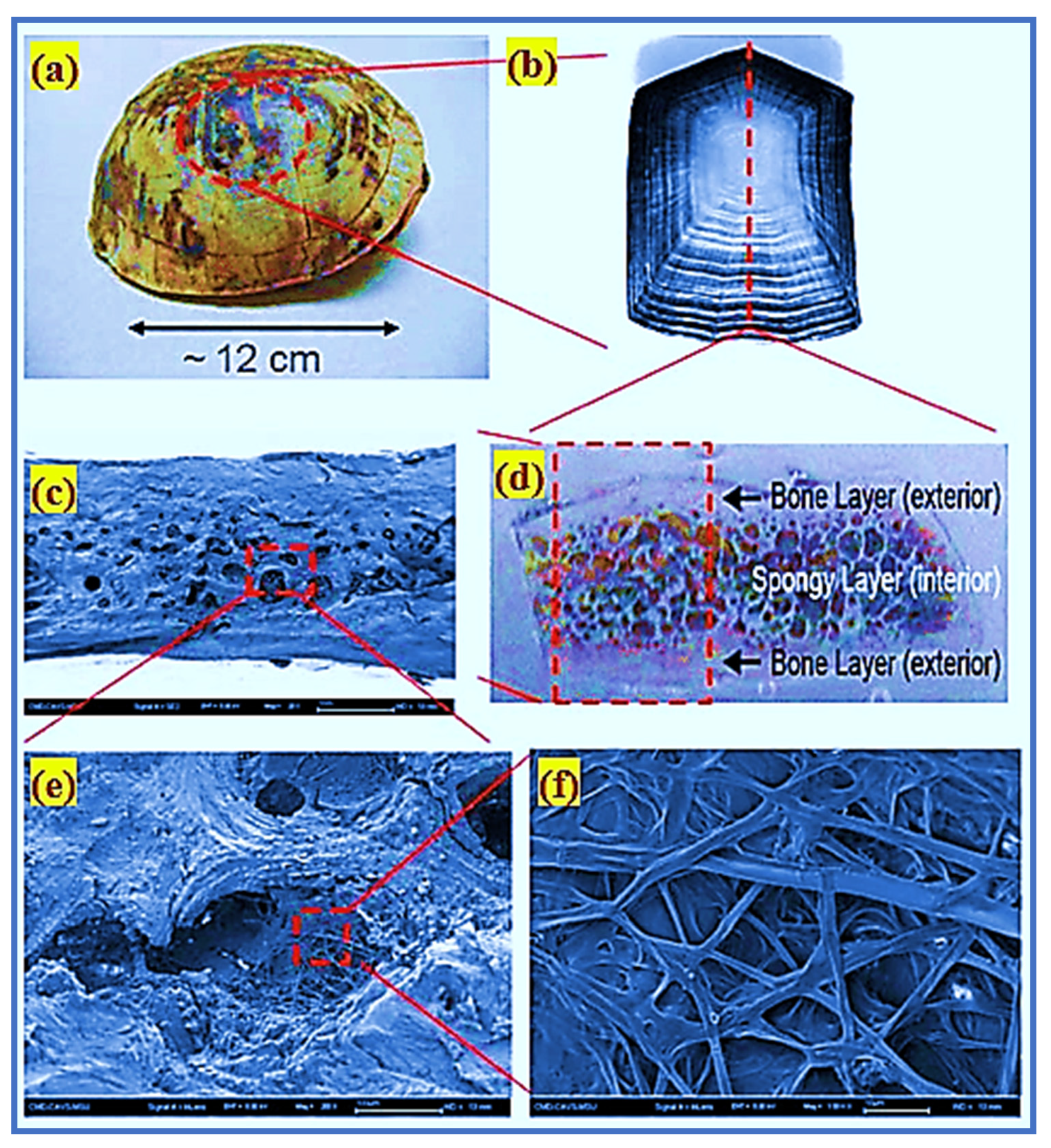



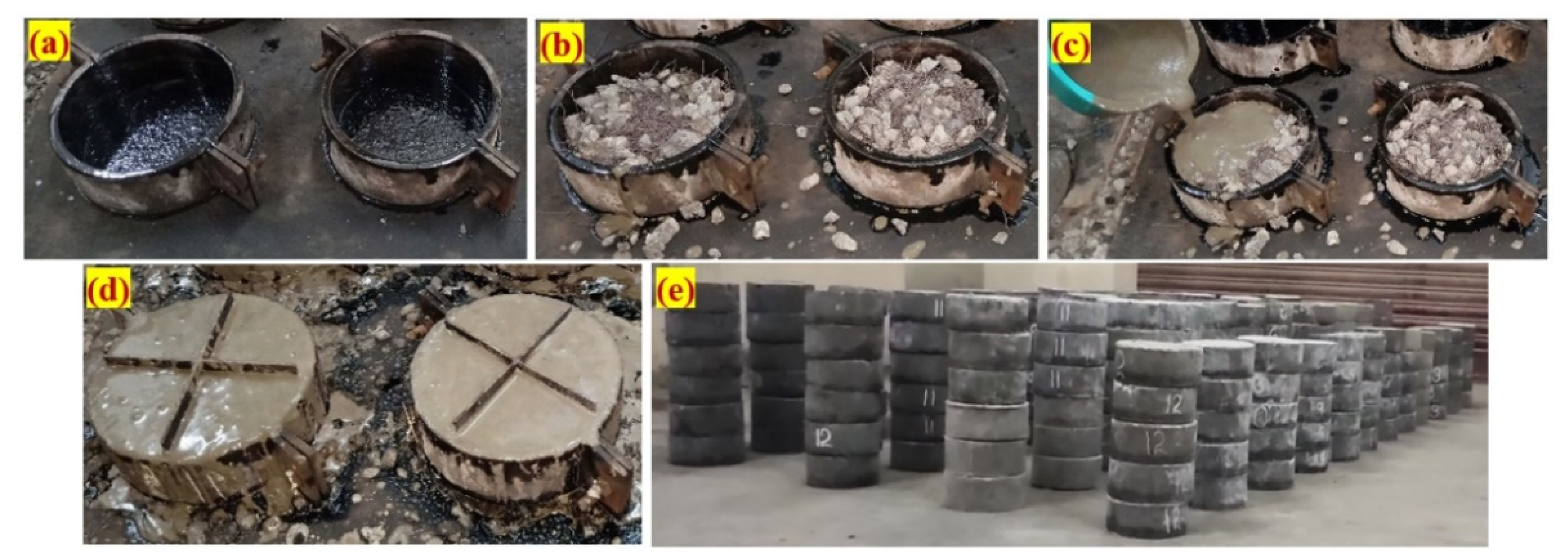
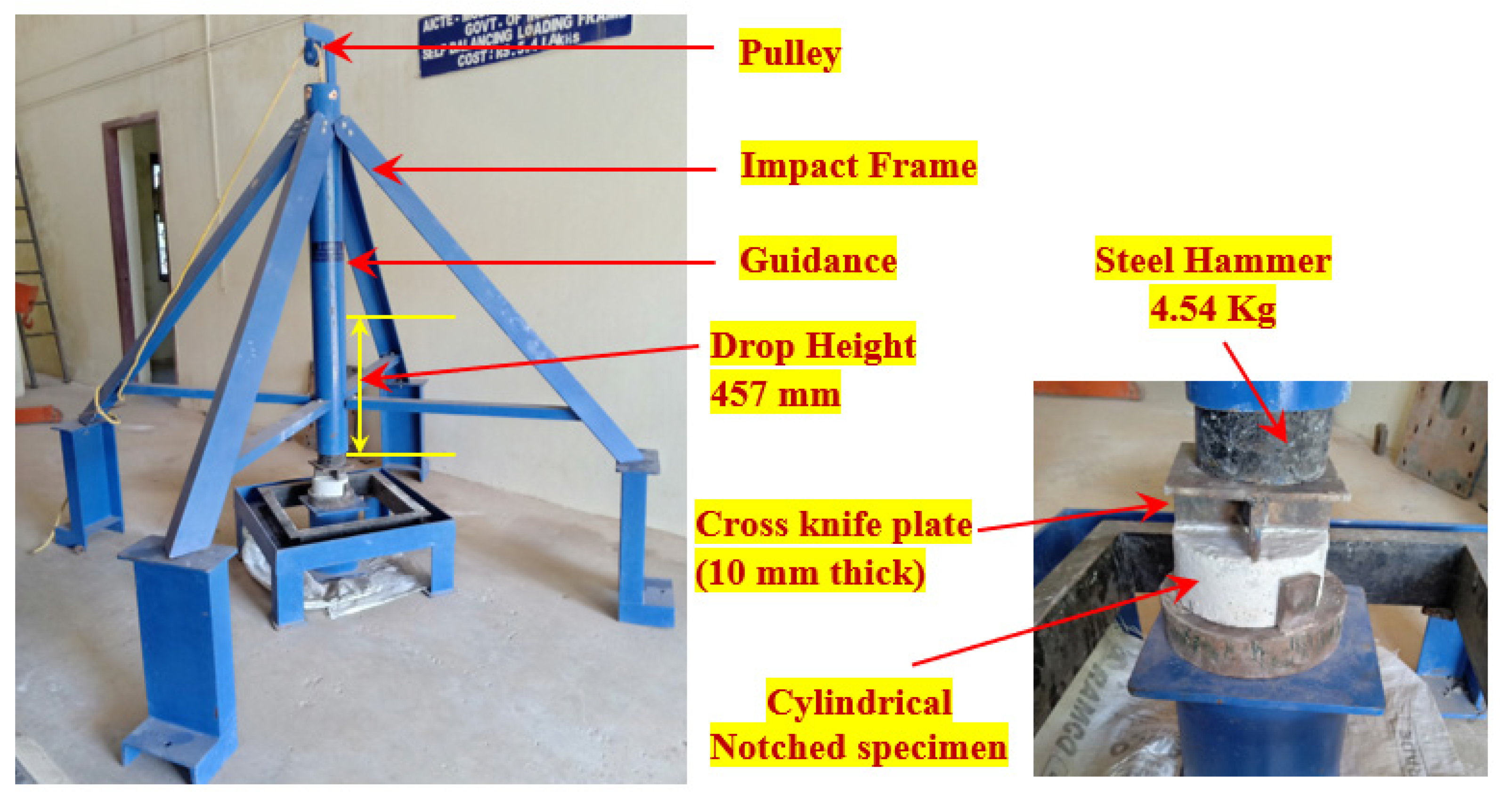


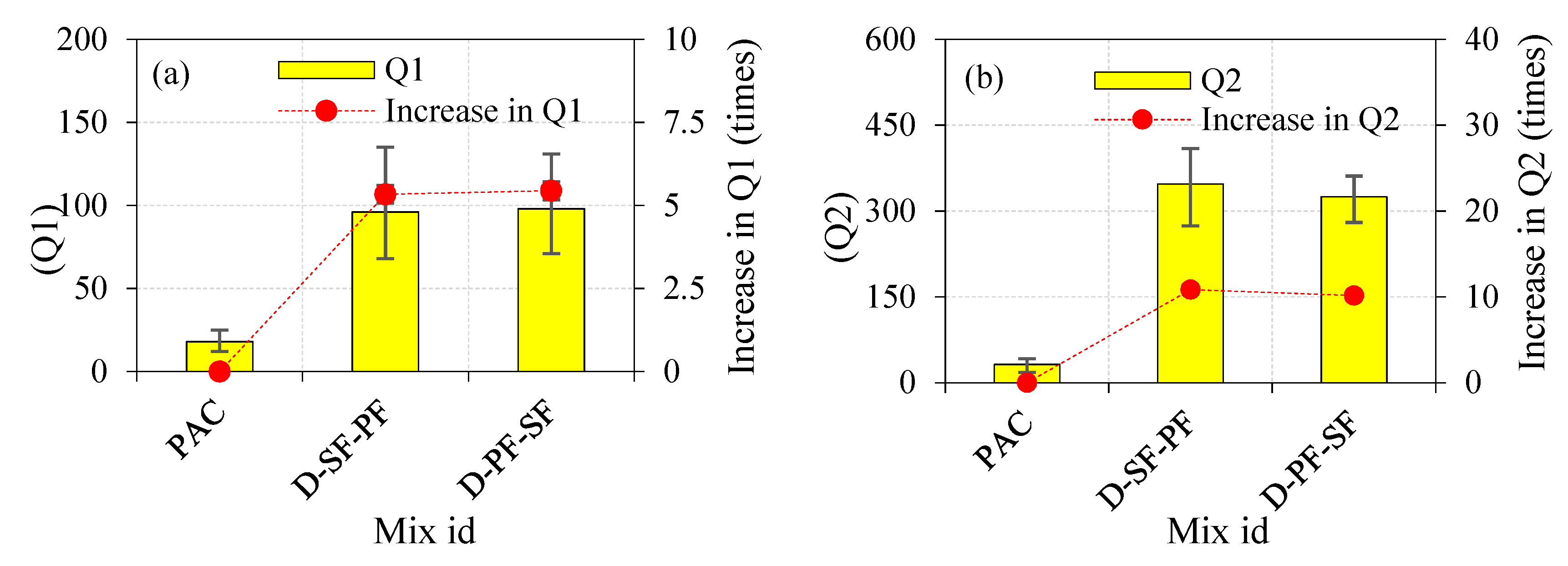
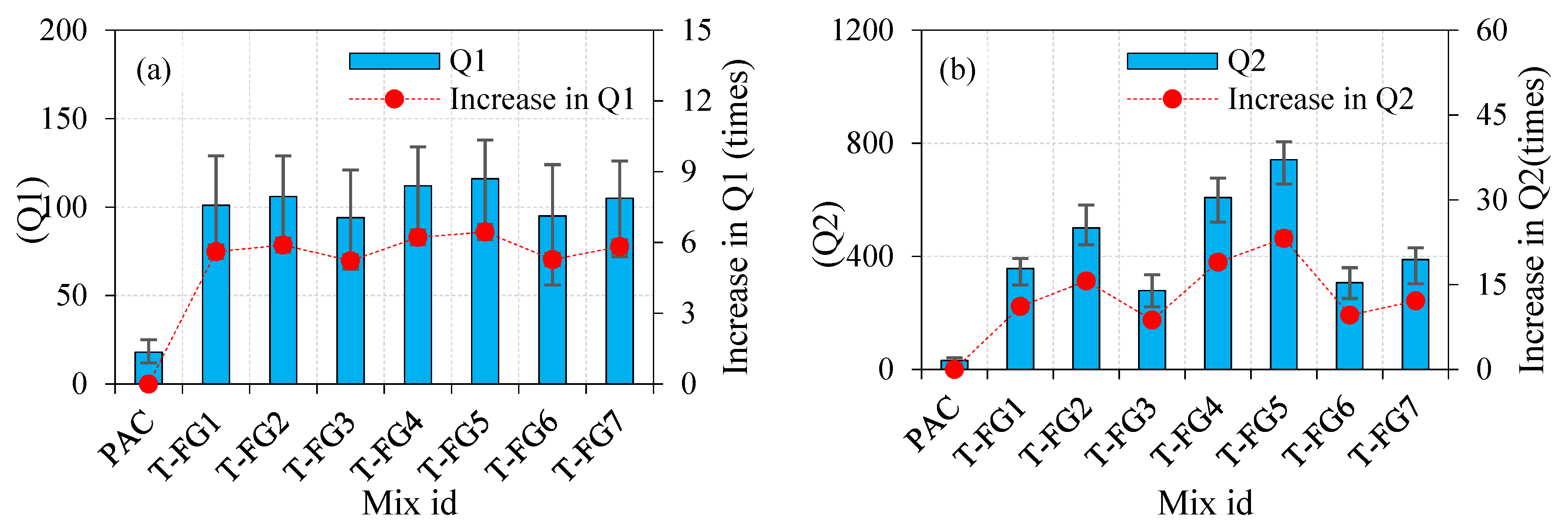
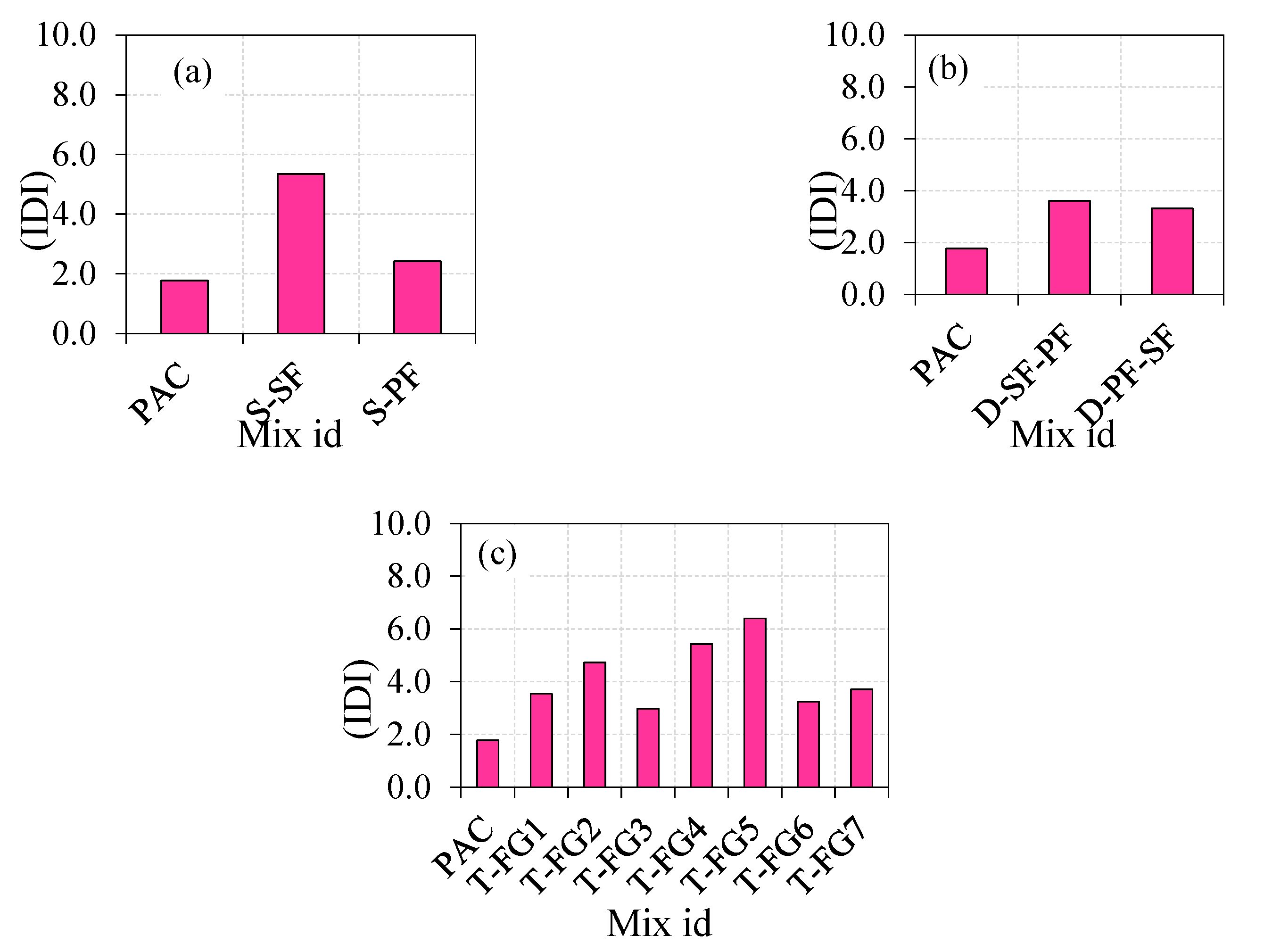
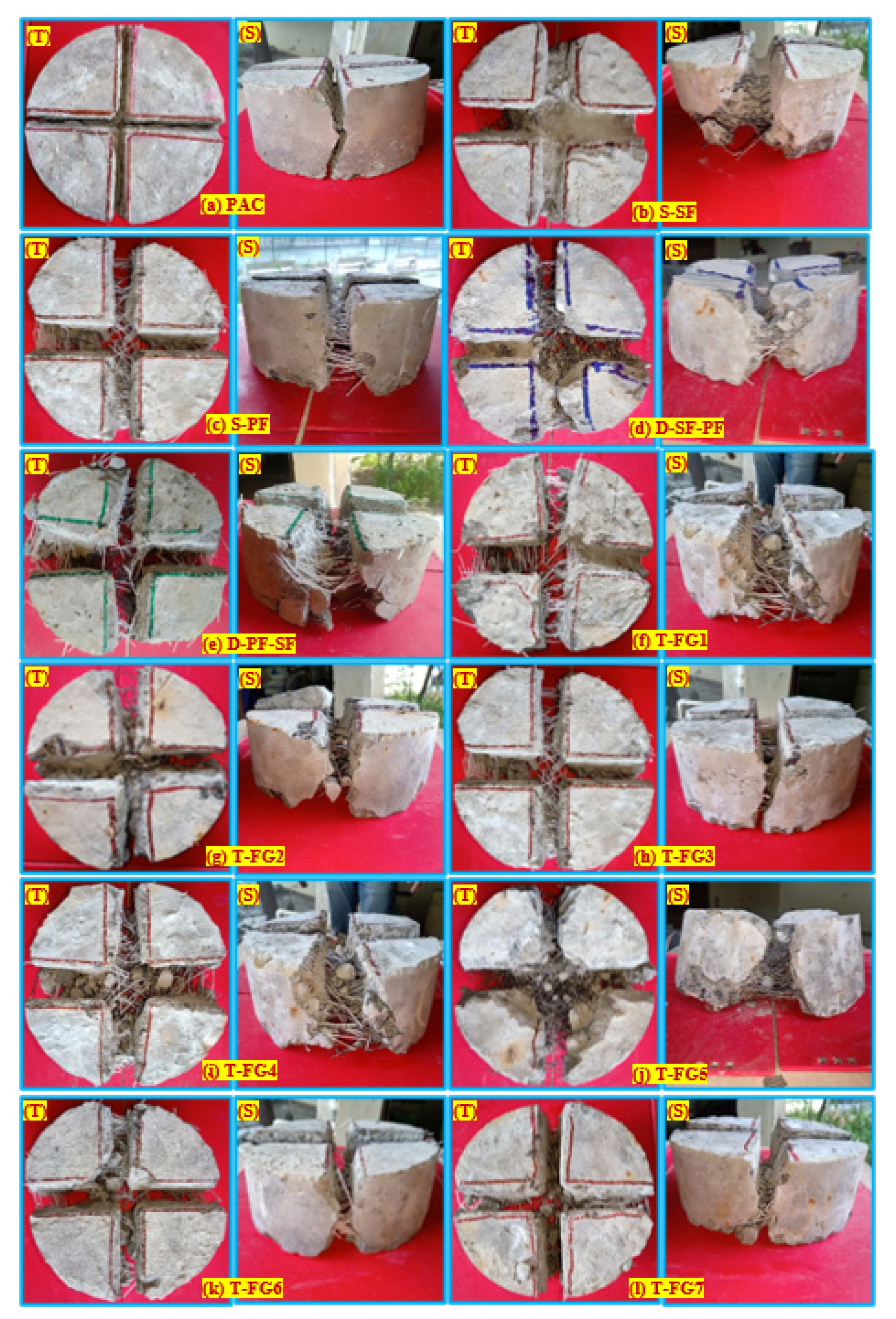

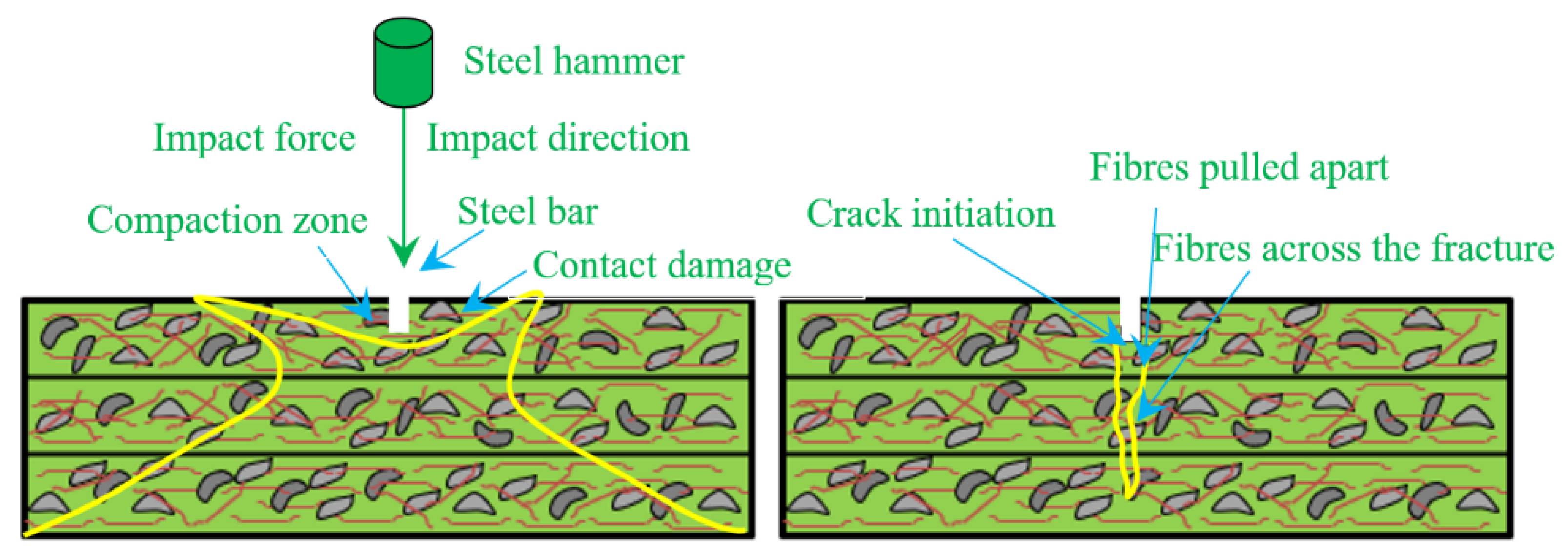
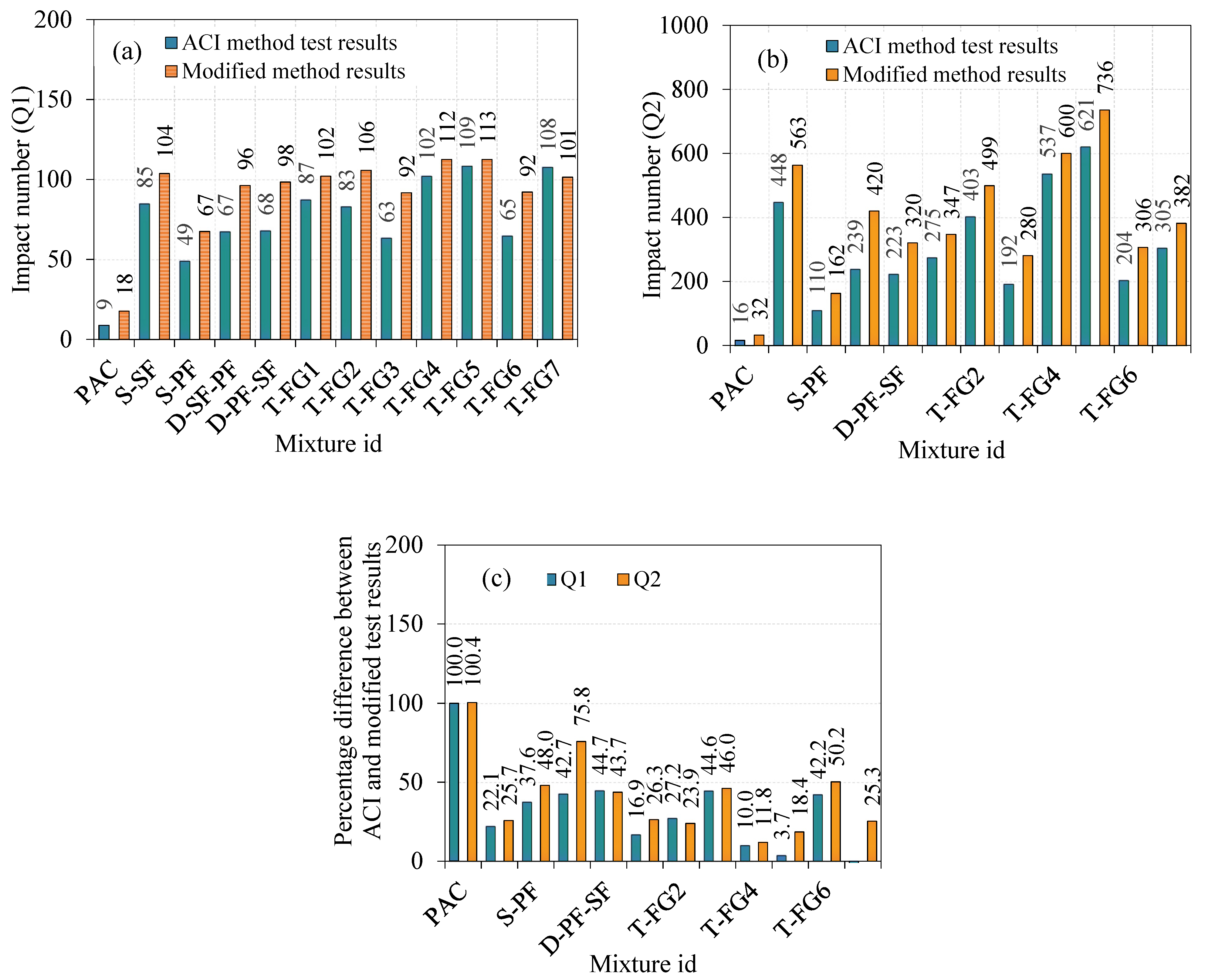
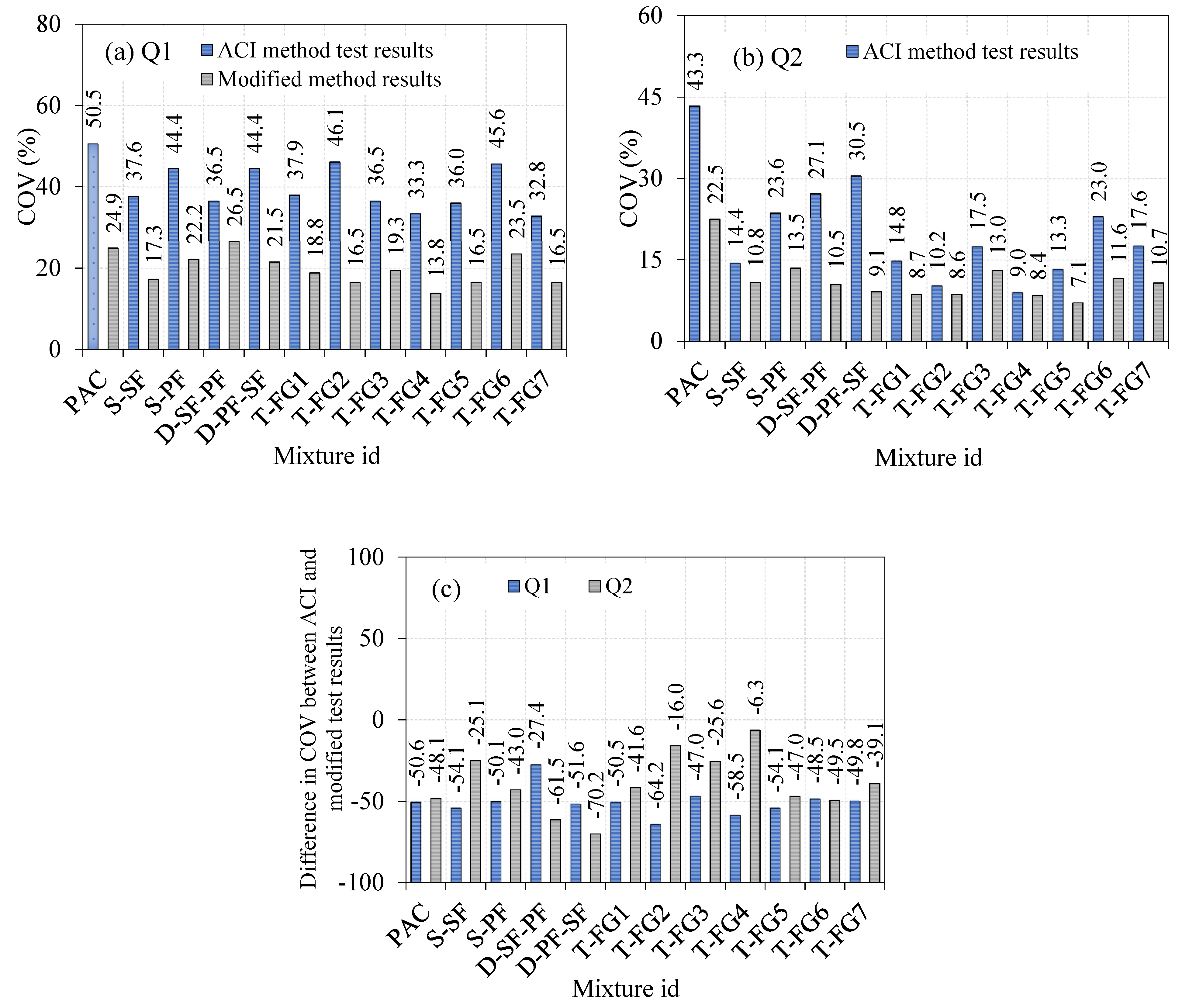
| Mix ID | Type of Composite | Dosage of Fibre (%) | Fibre Type | Sample Tested Per Mixture | Impact Failure Numbers | SD | COV (%) | Ref. |
|---|---|---|---|---|---|---|---|---|
| PC, CF1.5, CF3.0, CF5.0, HF1.5, HF3.0, HF5.0 | Two stage fibrous concrete | 1.5, 3.0, 5.0% | Crimped steel, hooked-end steel | 15 | 84, 312, 737, 1209, 424, 918, 1378 | 25, 86, 113, 151, 64, 78, 122 | 30, 27, 15, 12, 15, 9, 9 | [18] |
| GHPC, GHPSFRC | Green high-performance plain and FRC | 0.5% | Steel | 40 | 177, 240 | 81, 94 | 46, 39 | [66] |
| M0, M1, M2, M3 | Geopolymer fibre-reinforced concrete | 1.6, 0.3, 0.3% | Steel, polypropylene, glass | 5 | 14, 101, 32, 35 | 4.7, 20.3, 9.5, 11.7 | 33.5, 20.1, 30.1, 33.6 | [45] |
| B1, B2 | Fibre-reinforced concrete | 3 kg/m3 | Polypropylene fibre | 20 | 84, 76 | 44, 37 | 52, 49 | [58] |
| G1, G2 | Fibre-reinforced concrete | 2.5% | Steel | 15 | 358, 417 | 207, 185 | 58, 44 | [55] |
| SC30-0, SC30-0.5, SC30-0.75, SC30-1.0 | Self-compacting fibre-reinforced concrete | 0.5, 0.75, 1.0% | Steel | 6 | 1.8, 7.3, 11.3, 17.2 | 0.8, 1.6, 1.6, 4.8 | 41.1, 22.3, 14.4, 27.9 | [67] |
| HSFRC | High-strength fibre-reinforced concrete | 1% | Hooked-end steel fibre | 48 | 1896 | 802 | 42 | [56] |
| M1 | Fibre-reinforced concrete | 2.5% | Steel | 12 | 127 | 47 | 37 | [68] |
| PC, CFRC, PRFC, SFRC | Fibre-reinforced concrete | 0.15, 0.15, 0.5% | Cellulose fibre, polypropylene fibre, steel fibre | 32 | 48, 118, 71, 228 | 28, 53, 36, 90 | 57, 45, 51, 39 | [59] |
| NC, PP4, PP6, SF20, SF35 | Fibre-reinforced concrete | 4, 6, 20, 35 kg/m3 | Polypropylene, steel | 6 | 15, 33, 40, 52, 55 | 7, 7, 5, 27, 24 | 47, 21, 12, 52, 44 | [53] |
| Mix ID | Ratio of c/s | Ratio of w/c | Dosage of Fibre Used in the First Layer (%) | Dosage of Fibre Used in the Second Layer (%) | Dosage of Fibre Used in the Third Layer (%) | SP (%) | |||
|---|---|---|---|---|---|---|---|---|---|
| SF | PF | SF | PF | SF | PF | ||||
| PAC | 1.0 | 0.45 | 0 | 0.3 | |||||
| S-SF | SF (2.4) | 0.4 | |||||||
| S-PF | PF (2.4) | 0.4 | |||||||
| D-SF-PF | SF (2.4) | PF (2.4) | 0.4 | ||||||
| D-PF-SF | PF (2.4) | SF (2.4) | 0.4 | ||||||
| T-FG1 | 1.2 | 1.2 | 1.2 | 1.2 | 1.2 | 1.2 | 0.4 | ||
| T-FG2 | 2.8 | 0 | 1.6 | 0 | 2.8 | 0 | 0.4 | ||
| T-FG3 | 0 | 2.8 | 0 | 1.6 | 0 | 2.8 | 0.4 | ||
| T-FG4 | 1.4 | 1.4 | 0.8 | 0.8 | 1.4 | 1.4 | 0.4 | ||
| T-FG5 | 3.6 | 0 | 0 | 0 | 3.6 | 0 | 0.4 | ||
| T-FG6 | 0 | 3.6 | 0 | 0 | 0 | 3.6 | 0.4 | ||
| T-FG7 | 1.8 | 1.8 | 0 | 0 | 1.8 | 1.8 | 0.4 | ||
| Mix ID | PAC | S-SF | S-PF | D-SF-PF | D-PF-SF | T-FG1 | T-FG2 | T-FG3 | T-FG4 | T-FG5 | T-FG6 | T-FG7 | ||||||||||||
|---|---|---|---|---|---|---|---|---|---|---|---|---|---|---|---|---|---|---|---|---|---|---|---|---|
| Q1 | Q2 | Q1 | Q2 | Q1 | Q2 | Q1 | Q2 | Q1 | Q2 | Q1 | Q2 | Q1 | Q2 | Q1 | Q2 | Q1 | Q2 | Q1 | Q2 | Q1 | Q2 | Q1 | Q2 | |
| 1 | 12 | 18 | 79 | 456 | 48 | 122 | 68 | 274 | 71 | 280 | 71 | 299 | 75 | 441 | 65 | 222 | 85 | 521 | 85 | 656 | 56 | 251 | 72 | 303 |
| 2 | 12 | 22 | 81 | 486 | 49 | 129 | 69 | 281 | 73 | 284 | 76 | 305 | 79 | 449 | 69 | 235 | 88 | 535 | 88 | 661 | 61 | 258 | 78 | 315 |
| 3 | 13 | 25 | 85 | 491 | 51 | 136 | 71 | 298 | 77 | 288 | 78 | 315 | 84 | 459 | 72 | 241 | 93 | 546 | 90 | 672 | 66 | 261 | 83 | 332 |
| 4 | 14 | 27 | 89 | 502 | 54 | 141 | 73 | 301 | 81 | 291 | 84 | 319 | 90 | 464 | 76 | 249 | 99 | 551 | 91 | 685 | 74 | 273 | 88 | 353 |
| 5 | 15 | 29 | 93 | 532 | 56 | 153 | 76 | 311 | 82 | 296 | 88 | 327 | 96 | 471 | 79 | 256 | 104 | 562 | 97 | 701 | 80 | 285 | 92 | 361 |
| 6 | 15 | 30 | 96 | 542 | 59 | 158 | 78 | 322 | 83 | 302 | 95 | 331 | 101 | 479 | 84 | 263 | 109 | 575 | 105 | 716 | 86 | 293 | 94 | 372 |
| 7 | 15 | 31 | 99 | 555 | 61 | 165 | 83 | 340 | 88 | 312 | 99 | 343 | 107 | 486 | 88 | 271 | 114 | 584 | 110 | 730 | 88 | 299 | 99 | 384 |
| 8 | 17 | 33 | 102 | 569 | 65 | 168 | 87 | 345 | 94 | 321 | 104 | 347 | 109 | 491 | 92 | 277 | 116 | 601 | 117 | 741 | 93 | 308 | 103 | 394 |
| 9 | 18 | 35 | 109 | 587 | 68 | 170 | 94 | 355 | 101 | 329 | 111 | 356 | 112 | 500 | 91 | 286 | 119 | 615 | 120 | 751 | 97 | 317 | 106 | 401 |
| 10 | 19 | 37 | 113 | 595 | 74 | 175 | 101 | 360 | 108 | 334 | 114 | 361 | 115 | 505 | 98 | 294 | 121 | 632 | 124 | 763 | 101 | 321 | 109 | 409 |
| 11 | 20 | 38 | 119 | 601 | 79 | 178 | 121 | 374 | 114 | 345 | 116 | 368 | 119 | 515 | 104 | 305 | 123 | 638 | 128 | 777 | 108 | 329 | 112 | 414 |
| 12 | 22 | 39 | 124 | 612 | 82 | 180 | 126 | 384 | 119 | 351 | 120 | 374 | 121 | 528 | 109 | 315 | 125 | 646 | 130 | 782 | 112 | 337 | 116 | 415 |
| 13 | 23 | 40 | 128 | 621 | 86 | 184 | 130 | 394 | 125 | 353 | 122 | 381 | 123 | 543 | 112 | 326 | 127 | 656 | 131 | 794 | 116 | 341 | 121 | 419 |
| 14 | 24 | 41 | 134 | 644 | 89 | 188 | 131 | 399 | 129 | 359 | 124 | 385 | 125 | 575 | 115 | 331 | 130 | 662 | 134 | 802 | 119 | 356 | 122 | 424 |
| 15 | 25 | 42 | 138 | 656 | 90 | 190 | 135 | 409 | 131 | 361 | 129 | 392 | 129 | 582 | 121 | 335 | 134 | 677 | 138 | 806 | 124 | 360 | 126 | 430 |
| Mean | 18 | 32 | 104 | 563 | 67 | 162 | 96 | 420 | 98 | 320 | 102 | 347 | 106 | 499 | 92 | 280 | 112 | 600 | 113 | 736 | 92 | 306 | 101 | 382 |
| SD | 4.4 | 7.3 | 17.9 | 60.8 | 14.9 | 21.9 | 25.5 | 43.9 | 21.2 | 29.1 | 19.2 | 30.0 | 17.4 | 43.0 | 17.7 | 36.5 | 15.5 | 50.6 | 18.6 | 51.9 | 21.6 | 35.4 | 16.7 | 40.9 |
| COV % | 24.9 | 22.5 | 17.3 | 10.8 | 22.2 | 13.5 | 26.5 | 10.5 | 21.5 | 9.1 | 18.8 | 8.7 | 16.5 | 8.6 | 19.3 | 13.0 | 13.8 | 8.4 | 16.5 | 7.1 | 23.5 | 11.6 | 16.5 | 10.7 |
Publisher’s Note: MDPI stays neutral with regard to jurisdictional claims in published maps and institutional affiliations. |
© 2021 by the authors. Licensee MDPI, Basel, Switzerland. This article is an open access article distributed under the terms and conditions of the Creative Commons Attribution (CC BY) license (https://creativecommons.org/licenses/by/4.0/).
Share and Cite
Prasad, N.; Murali, G.; Vatin, N. Modified Falling Mass Impact Test Performance on Functionally Graded Two Stage Aggregate Fibrous Concrete. Materials 2021, 14, 5833. https://doi.org/10.3390/ma14195833
Prasad N, Murali G, Vatin N. Modified Falling Mass Impact Test Performance on Functionally Graded Two Stage Aggregate Fibrous Concrete. Materials. 2021; 14(19):5833. https://doi.org/10.3390/ma14195833
Chicago/Turabian StylePrasad, Nandhu, Gunasekaran Murali, and Nikolai Vatin. 2021. "Modified Falling Mass Impact Test Performance on Functionally Graded Two Stage Aggregate Fibrous Concrete" Materials 14, no. 19: 5833. https://doi.org/10.3390/ma14195833
APA StylePrasad, N., Murali, G., & Vatin, N. (2021). Modified Falling Mass Impact Test Performance on Functionally Graded Two Stage Aggregate Fibrous Concrete. Materials, 14(19), 5833. https://doi.org/10.3390/ma14195833








